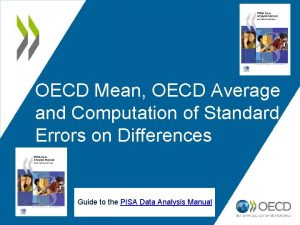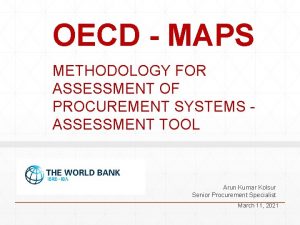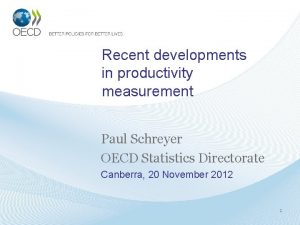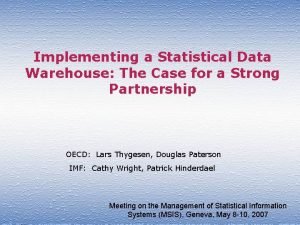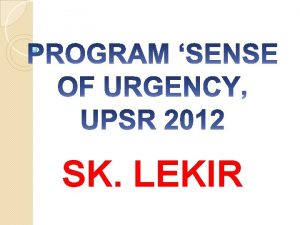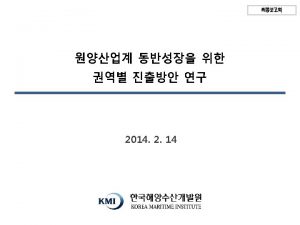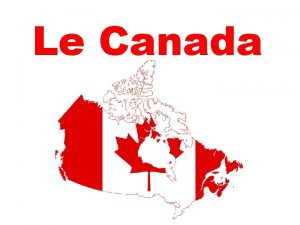OECD Economic Survey of Canada 2012 Peter Jarrett




























































- Slides: 60

OECD Economic Survey of Canada 2012 Peter Jarrett and Alexandra Bibbee June 14, 2012

Macroeconomic developments and policies

Real GDP growth Quarter-on-quarter, annual rate, %

Economic slack is diminishing

Inflationary pressures are emerging Year on year growth, in per cent g

Currency strength is weighing on exports Canadian-US dollar exchange rate, and ratio

The share of manufacturing in real GDP Canada versus the United States

The share of manufacturing in total employment Canada versus the United States

The shifting pattern of real per capita income As a share of the national average

Short-term projections Annual percentage change, volume (chained 2002 CAD) 2011 2012 2013 Private consumption 2. 2 2. 4 2. 9 Government consumption 1. 2 0. 2 -0. 5 Gross fixed capital formation 6. 9 3. 9 5. 0 Private residential Private non-residential 2. 3 3. 7 2. 6 13. 7 7. 1 7. 2 Total domestic demand 3. 2 2. 0 2. 7 Exports of goods and services 4. 4 5. 2 6. 2 Imports of goods and services 6. 5 4. 3 6. 3 GDP at market prices 2. 5 2. 2 2. 6 Demand output

Short-term projections (continued) Annual percentage change, volume (chained 2002 CAD) 2011 2012 2013 Consumer price index 2. 9 2. 3 2. 2 Underlying price index 1. 7 2. 1 2. 0 Total employment 1. 5 1. 1 Unemployment rate 7. 5 6. 9 6. 6 General government financial balance 1 Cyclically adjusted government primary balance 1 -4. 5 -3. 5 -2. 4 -3. 7 -2. 9 -2. 1 General government gross debt 1 83. 8 84. 5 81. 4 General government net debt 1 33. 3 35. 3 36. 3 1. 2 1. 3 2. 1 Current account balance 1 -2. 8 -2. 4 -2. 3 Output gap (per cent of potential GDP) -1. 1 -1. 0 -0. 6 Prices and employment Memorandum items Short-term interest rate 1. As a percentage of GDP.

Households’ indebtedness indicators

Debt-to-disposable income ratios, 2010

Residential investment as a share of GDP

Nominal house prices Index, 2000 q 1 = 100

House price to income ratio Index, 2000 = 100

House price to rent ratio Index, 2000 = 100

Mortgage service ratio and long-term average Per cent 1. The proportion of the average personal disposable income per worker that goes towards mortgage payments on a quarterly basis based on current house prices and mortgage rates.

Unoccupied housing completions Share of total completions by type

Monetary and financial policy recommendations • Maintain the current official rate for now (and cut them further if a crisis ensues) • If downside risks avoided, start removing stimulus in the fall and continue through 2013 (125 basis points) • Follow through on macroprudential moves, especially having CMHC supervised by OSFI • Implement as comprehensive a securities market regulator as possible

Net debt as % of GDP

Share of market-based income inequality offset by the tax and transfer system

Health care expense indicators 1. CIHI projections.

Population 65 years of age and over Percentage of total

Fiscal policy recommendations • Implement consolidation plans as budgeted, but slow it if prospects weaken significantly • Implement rise in pension age as planned • Eliminate inefficient tax expenditures, especially those that are regressive • Adopt a target long-term public debt ratio

Unleashing business innovation • The Canadian puzzle • Innovation drivers • Policy solutions

Economic Performance of Canada relative to the United States Total economy

Research and development expenditure As a percentage of GDP

ICT investment in Canada relative to USA = 100

Science and innovation profile of Canada 2010 or latest available year

Intangible investments, selected OECD countries Business sector, as a per cent of GDP Computerised information Software Australia (2005 -06) Canada (2005) Japan (2005) United States (2007) EU 27 + Norway (2005) Economic competencies Innovative property Total Scientific R&D Mineral exploration Other Firm specific capital Brand equity 0. 77 0. 82 0. 26 1. 17 0. 87 2. 02 5. 90 1. 03 1. 83 1. 14 2. 03 0. 49 3. 26 9. 78 2. 14 2. 88 0. 00 2. 95 1. 14 1. 56 10. 67 1. 38 1. 82 1. 01 1. 82 1. 43 4. 01 11. 43 1. 04 n. a. 1. 31 0. 93 2. 16 6. 49

Share of high technology manufacturing in GDP 2009 or latest available year

Business R&D intensity and natural resource intensity 2000 to latest available year

Product and labour market regulation indicators Index scale of 0 -6 from least to most restrictive

Educational attainment of managers and workers Bachelor degree and higher

Fiscal support for business R&D investment 2009 As a percentage of GDP

Tax subsidy rate on investment in R&D 2009, percentage

VC funding sources in Canada and the United States 2011

Recommendations for enhancing innovation Ø General framework conditions • Open network industries (especially telecoms) and implement Ch. 7 (on labour mobility) of the AIT • Clarify FDI net benefit test and apply it narrowly • Encourage entrepreneurship/risk taking/culture of commerce Ø R&D support policies • Lower small CCPC rate toward large firm rate and reinstate capital costs in eligible base; use SR&ED savings to boost direct grants • Subject IRAP and other R&D support to rigorous cost/benefit analysis • Carefully design VC support, e. g. as temporary co-financing arrangements with private partners, giving them full management control Ø Technology transfer • Promote academic-business knowledge sharing • Provide IP (patenting) support to small business

Tertiary education Developing skills for innovation and long-term growth

Unemployment rate by education level Per cent

Productivity and university attainment across provinces

Relative earnings of 25 -64 year-olds with tertiary education, 2009 Upper secondary and post-secondary non-tertiary education = 100

Earnings premium and employment rate relative to high school graduates Per cent

Employment of tertiary graduates by skill level University graduates 1997 2007 Management or occupations usually requiring university 65. 0% 60. 8% Occupations usually requiring college or apprenticeship training Occupations usually requiring high school 19. 2% 20. 2% 13. 1% 15. 4% Occupations usually requiring on‑the‑job training 2. 8% 3. 6% Management or occupations usually requiring university 22. 1% 20. 2% Occupations usually requiring college or apprenticeship training Occupations usually requiring high school 43. 9% 43. 1% 26. 2% 29. 5% Occupations usually requiring on‑the‑job training 7. 8% 7. 2% College graduates

Population with tertiary education, 2009 Percentage of the population age group

Participation rates in university and college By family income among 18 to 24 year-olds, per cent

Tertiary participation by parental education Among 18 to 24 year-olds, per cent

Master’s and Ph. D graduation rates, 2009 Sum of graduation rates for single year of age Note that the OECD’s use of the term ""graduation rate"" does not correspond to the concept of a graduation rate used by provincial and territorial governments in Canada. OECD uses the term ""graduation rate"" to refer to the number of graduates (of any age) as a share of the population at the typical age of graduation. This is how the term is used in this report. This should not be confused with what OECD calls a ""completion rate"", and what in Canada is more commonly referred to as a graduation rate, which reports on what percentage of a group of students starting a program have completed it (or graduated) within a certain time frame.

Share of university graduates by field 2009

Science & engineering Ph. D graduates, 2009¹ As a percentage of all new degrees awarded at doctorate level

Average tuition fees in real terms by province 2008 CAD

University full-time tuition fees 2008/09, in equivalent USD converting using PPPs

Public subsidies for tertiary education 2008, percentage of total public expenditure on education

Funding for tertiary education

Expenditure on tertiary education institutions 2008, percentage of GDP

Class sizes in Canadian universities Ratio of full-time students to full-time teaching staff

The global market in tertiary education, 2009 Number of foreign students enrolled in a given destination country as a percentage of all students enrolled abroad

Recommendations to improve tertiary education • Improve access by boosting need-based aid (financed by reduced education tax credits) and making the application process more transparent • Provide more info to support education choices • Use the tertiary system more to recruit migrants • Consider greater differentiation across TEIs as regards research versus teaching

Thank you for your attention! For more information: peter. jarrett@oecd. org alexandra. bibbee@oecd. org
 Peter jarrett
Peter jarrett Oecd economic outlook
Oecd economic outlook Peter green oecd
Peter green oecd Jarrett billingsley
Jarrett billingsley Jarrett billingsley
Jarrett billingsley Jarrett billingsley
Jarrett billingsley Pete jarrett
Pete jarrett Jarrett billingsley
Jarrett billingsley Ample abcde
Ample abcde What is canada's economic system
What is canada's economic system Economic growth vs economic development
Economic growth vs economic development Conclusion of growth and development
Conclusion of growth and development Chapter 1 lesson 2 our economic choices worksheet answers
Chapter 1 lesson 2 our economic choices worksheet answers Oecd meaning
Oecd meaning Oecd trade
Oecd trade Asta auerbach
Asta auerbach Oecd working group on bribery
Oecd working group on bribery Oecd trade facilitation indicators
Oecd trade facilitation indicators Andrew bell oecd
Andrew bell oecd Principles of glp
Principles of glp Oecd nations meaning
Oecd nations meaning Oecd maps
Oecd maps Oecd modellegyezmény magyarul
Oecd modellegyezmény magyarul Oecd scenarios for the future of schooling
Oecd scenarios for the future of schooling Paul schreyer oecd
Paul schreyer oecd Oecd well being framework
Oecd well being framework Francesca colombo oecd
Francesca colombo oecd Evaluation cooperation group
Evaluation cooperation group Oecd
Oecd Civil service skills
Civil service skills Pavida pananond
Pavida pananond Claire jolly
Claire jolly Oecd guidelines on measuring subjective well-being
Oecd guidelines on measuring subjective well-being Oecd better life initiative
Oecd better life initiative Oecd corporate governance principles
Oecd corporate governance principles Oecd guidelines on corporate governance
Oecd guidelines on corporate governance Oecd
Oecd Oecd qsar toolbox
Oecd qsar toolbox Oecd meaning
Oecd meaning Oecd stands for
Oecd stands for Oecd countries
Oecd countries Oecd
Oecd William hynes oecd
William hynes oecd Eurostat e commerce
Eurostat e commerce Oecd 207
Oecd 207 Oecd good practices for performance budgeting
Oecd good practices for performance budgeting Oecd principles of corporate governance
Oecd principles of corporate governance Oecd corporate governance definition
Oecd corporate governance definition William hynes oecd
William hynes oecd Oecd business restructuring
Oecd business restructuring Oecd trade facilitation indicators
Oecd trade facilitation indicators Oecd data warehouse
Oecd data warehouse Ybl 2018
Ybl 2018 Iinn 2012
Iinn 2012 Remote desktop virtualization host role server 2012
Remote desktop virtualization host role server 2012 Windows multipoint server 2012
Windows multipoint server 2012 Jayco sterling 2012 brochure
Jayco sterling 2012 brochure Manual windows movie maker
Manual windows movie maker Jorc code 2012
Jorc code 2012 Parallel data warehouse sql server 2012
Parallel data warehouse sql server 2012 Subjek upsr
Subjek upsr




















